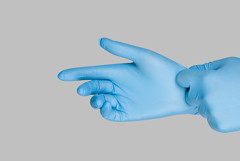Harvard Health Blog
Can’t touch this: “Latex-free” labels are misleading

If you or a loved one has a latex allergy or sensitivity, think twice before reaching for a product that says “latex free” or “does not contain latex.” That’s the latest advice from the FDA, which says no existing tests can show that a product is completely free from latex. Labeling that suggests a product doesn’t contain the substance could cause trouble for individuals with a latex allergy or sensitivity.
The original latex came from the sap of the rubber tree (Hevea brasiliensis), earning it the designation of “natural rubber latex.” It is used to make a host of stretchy products, including adhesive bandages, condoms, gloves used in health care and dishwashing, balloons, rubber band, elastic used in waistbands and socks, baby bottle nipples, pillows, and more. Natural rubber latex contains proteins that set off some people’s immune systems, leading to an allergic reaction. An alternative, synthetic latex, doesn’t contain these proteins and so doesn’t provoke allergies.
Although anyone can develop a latex allergy, it usually occurs in people with repeated exposure to the rubber proteins. Allergies to latex skyrocketed in the 1990s as a more and more people (mostly in healthcare and associated professions) were required to use gloves to avoid getting and spreading infections. Although the use of alternatives has decreased latex allergies, up to 12% of healthcare workers and up to 6% of the general population may have a latex allergy or sensitivity. “The most common patient is a healthcare worker or frequent surgical patient,” says Dr. Peter Schalock, assistant professor of dermatology at Harvard-affiliated Massachusetts General Hospital.
According to the American Latex Allergy Association, the signs of a latex allergy, which is really a system-wide immune reaction, include
- hives or welts
- swelling of the affected area
- a runny nose
- sneezing
- reddened, itchy, or teary eyes
- headache
- sore throat, hoarse voice
- abdominal cramps
- chest tightness, wheezing, or shortness of breath (asthma)
Sometimes the reaction is so powerful it can put a person into anaphylactic shock, which can be deadly.
There’s no cure for a latex allergy. That makes avoiding latex a must.
Inflames on contact
Not everyone who is latex sensitive has a full-blown allergy. Some people get contact dermatitis—a skin rash and itching that start one to several days after contact with a latex product. With repeated exposure, it can get pretty nasty, with dry and crusted scabs on the skin. “Most of what we see in the allergic contact dermatitis clinic is hand rashes from the rubber accelerators in latex and some non-latex gloves,” Dr. Schalock says.
Accelerators are a type of chemical used to manufacture latex products. The person’s skin reacts to the chemical, not the latex proteins. For these people, Dr. Schalock says, the remedy is antihistamines, like diphenhydramine (Benadryl) or cetirizine (Zyrtec) and “complete avoidance in the future.”
Shopping to avoid latex
Since latex is found in so many products, latex-sensitive consumers have to trust labels. But the FDA’s warning highlights that products advertised as “latex-free” may not always live up to the claim. That’s because products that are made without latex can be contaminated with latex proteins during the manufacturing or packaging process.
Instead of “latex free” and “does not contain latex,” the FDA wants labels to say “not made with natural rubber latex.” That still leaves the latex-sensitive crowd at risk, because it’s not possible to certify that a product is truly “latex-free.”
For anyone with latex sensitivity, it’s best to approach potential triggering products with caution.
About the Author

Daniel Pendick, Former Executive Editor, Harvard Men's Health Watch
Disclaimer:
As a service to our readers, Harvard Health Publishing provides access to our library of archived content. Please note the date of last review or update on all articles.
No content on this site, regardless of date, should ever be used as a substitute for direct medical advice from your doctor or other qualified clinician.












